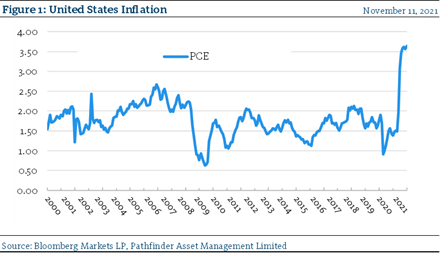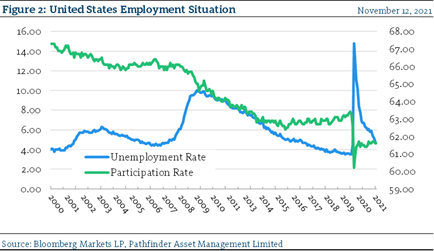Prices and Jobs
It has been some time since we have written about recent employment and inflation trends. Both are important parts of the economy and are also the main considerations that impact administered interest rate policy and open market operations applied by the US Federal Open Market Committee (“FOMC”). The FOMC has the dual mandate of providing full employment and stable prices. Inflation and employment issues have been major topics in the financial press and are clearly observable in our daily lives. The FOMC uses the Personal Consumption Expenditure Index (PCE) as its preferred measure of inflation, and global inflation data released this week has caused some fixed income and equity volatility.
- The PCE is a broad measure of prices of goods and services purchased by all households across the United States. Because of its depth and more regular composition updates, the PCE tends to be less influenced by major price movements in certain products like gasoline. Thus, the index smooths major swings and is a good measure of current inflation.

- Figure 1 presents the data over the past 20 years. As you can see, prices are now the highest in the last 2 decades. The last period of elevated inflation was in the early 2000’s during the commodity boom in the run up to the Great Financial Crisis. By comparison, prices are significantly higher now but materially lower than the 1970’s through early 1990’s when PCE inflation ranged from 4% to 10%.

Employment is also significantly in influx. As you can see from Figure 2, actual Unemployment is low (blue line) but not as low as it was before the pandemic. The Participation Rate (green line) shows that since the pandemic, 2% of Americans have left the job market. Indeed, with many stories of both elevated resignations and employee shortages, depending on the industry, the current employment situation is complex. Most investors suspect that this will also lead to further inflation given recent wage growth trends as well.
“This means that” the global economy continues to recover. The trends in inflation and employment are still fluctuating along with major forces that have resulted from reaction to the pandemic. It will take some time for this to work itself out.
National Instrument 31-103 requires registered firms to disclose information that a reasonable investor would expect to know, including any material conflicts with the firm or its representatives. Doug Johnson and/or Pathfinder Asset Management Limited are an insider of companies periodically mentioned in this report. Please visit www.paml.ca for full disclosures.
*All returns are time weighted and net of investment management fees. Returns from the Pathfinder Partners’ Fund and Partners’ Real Return Plus Fund are presented based on the masters series of each fund. The Pathfinder Core: Equity Portfolio and The Pathfinder Core: High Income Portfolio are live accounts. These are actual accounts owned by the Pathfinder Chairman (Equity) and client (High Income) which contain no legacy positions, cash flows or other Pathfinder investment mandates or products. Monthly inception dates for each fund and portfolio are as follows: Pathfinder Core: Equity Portfolio (January 2011), Pathfinder Core: High Income Portfolio (October 2012) Partners’ Fund (April 2011), Partners’ Real Return Plus Fund (April, 2013), and Partners’ Core Plus Fund (November 2014).
Pathfinder Asset Management Limited (PAML) and its affiliates may collectively beneficially own in excess of 10% of one or more classes of the issued and outstanding equity securities mentioned in this newsletter. This publication is intended only to convey information. It is not to be construed as an investment guide or as an offer or solicitation of an offer to buy or sell any of the securities mentioned in it. The author has taken all usual and reasonable precautions to determine that the information contained in this publication has been obtained from sources believed to be reliable and that the procedures used to summarize and analyze such information are based on approved practices and principles in the investment industry. However, the market forces underlying investment value are subject to sudden and dramatic changes and data availability varies from one moment to the next. Consequently, neither the author nor PAML can make any warranty as to the accuracy or completeness of information, analysis or views contained in this publication or their usefulness or suitability in any particular circumstance. You should not undertake any investment or portfolio assessment or other transaction on the basis of this publication, but should first consult your portfolio manager, who can assess all relevant particulars of any proposed investment or transaction. PAML and the author accept no liability of any kind whatsoever or any damages or losses incurred by you as a result of reliance upon or use of this publication.